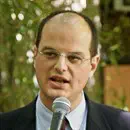
A few days ago more than a dozen graves at the Mount of Olives cemetery in Jerusalem were vandalized, the latest in a series of attacks on the Judaism's oldest cemetery. The recent damage is in addition to vandalism sustained at the cemetery on 'Nakba Day'.
During riots, Palestinians hurled large rocks and boulders toward the graves, chipping and breaking at least 15.
The attacks on the Jewish tombs are emblematic of the Islamist's obsession about the very Jewish presence in the land, because a nation without a past can never anticipate a future. This concept is built into the very fabric of the Hebrew language, since the Hebrew word "kever" means both grave and womb.
In the Middle Ages, pogroms and desecrations of Jewish cemeteries used to occur together. During the Kristallnacht of 1938 in Germany, Jewish cemeteries became a particular object of desecration in many regions. In the Soviet Union the Jewish graves were often destroyed during the many waves of anti-Semitism.
There are an estimated 150,000 graves on the Mount of Olives, where Jews have been buried since biblical times. This cemetery has always been the primary target of anti-Semitic hatred. Notable individuals buried there include the prophets Zechariah, Malachi and Hagai; famous modern rabbis; Henrietta Szold, founder of Hadassah; Hazzan (Cantor) Yossele Rosenblatt; and British Parliament member Robert Maxwell.
Studded with thousands of tombstones, the Mount of Olives is the resting place of thousands of Jews ranging from unknown mediaeval beggars to former prime minister Menachem Begin. The first graves discovered in excavations date back some 2,600 years before the Muslim conquest of Jerusalem.
According to the Midrash, the famed olive branch carried by the dove back to Noah's ark after the flood was plucked from the Mount of Olives. References in Torah, Talmud, and the Midrash cite other holy events and rituals that took place there, including the ritual preparation of the red heifer ashes.
Most widely known, Jewish tradition holds that resurrection of the dead on the Day of Judgment will happen on the Mount of Olives.
During its control of the area between 1948 and 1967, Jordan built a hotel and a road through the cemetery on Mount of Olives, desecrating a large number of graves. The Jordanians also used the broken headstones and pillaged others to build the latrines in the construction of the Intercontinental Hotel (since renamed the Seven Arches). The hotel likely rests on burial grounds. In 1
968, a year after Jerusalem was reunited under Israeli rule, a collection of plundered graves was hewn into a mass grave on the Mount of Olives. A second mass grave holds the civilians who fell during the siege of Jerusalem's Old City in 1948.
In recent years, efforts have resulted in the restoration of 2,000 of an estimated 40,000 graves on Mount of Olives that were destroyed prior to 1967 under Jordanian rule.
Cemetery vandalism against Mount of Olives became more frequent during and after the first Palestinian uprising in 1988. The youths who were arrested echoed a popular Palestinian argument when they told the police that the cemetery is Arab property. In 1997, vandals painted Menachem Begin's grave with a swastika and the graffiti: "Take out the bones of Menachem Begin and replace them with the bones of our fathers".
During the Second Intifada, the cemetery was more deserted than ever. Fewer families buried their loved ones there, fewer families visited it, and tourists were few.
In 2001, Jewish volunteers found remains of nearly two dozen 400- year-old tombstones under a garbage heap in the neighborhood of Silwan, next to the cemetery.
Many Jewish "settlers" have been slaughtered while they were defending and praying on the Biblical graves in Judea and Samaria (the last was a Breslav hassid killed near Joseph's tomb).
In 1929, after a pogrom that wiped out the entire Jewish community of Hevron, the Arabs destroyed the local Jewish cemetery. In 1948, the Jordanians razed the Jewish quarter of Hevron, desecrated the cemetery and built an animal pen on the ruins of the Avraham Avinu Synagogue.
In addition to the famous Tomb of the Patriarchs, Hebron also contains the tomb of Otniel Ben Kenaz, the first judge; the tomb of Avner Ben Ner, general and confidant to Saul and David; and the tombs of Ruth and Jesse, David's great-grandmother and father.
In 2000, an Arab mob assaulted the tomb of Joseph in Nablus/Shechem, painting the dome of the compound green (the color of Islam) and burning the Jewish books. Joseph's Tomb, under IDF control in the Oslo Accords, was attacked by hundreds of Palestinians throwing bricks, stones, firebombs and bottles and by Palestinian policemen who opened fire on IDF troops. Six Israeli soldiers were killed in 1996.
Several attacks and shootings took place also at Rachel's Tomb, a tiny stone building at the entrance to Bethlehem that is revered as the burial site of one of the Bible's great women, the wife of Jacob. With the outbreak of the second intifada in 2000, Palestinians again attacked Rachel's Tomb, and for 41 days Jews were prevented from visiting the site due to shooting incidents.
The war on the Jewish tomb has also been fought by Western forums: on October 21, 2010, Unesco, the UN organization for science and culture, declared that Rachel's Tomb is the Bilal ibn Rabah mosque - endorsing a Palestinian lie.
The Arab obsession to tear down the Jewish tombs recalls the Nazi's nihilism to destroy the Jewish cemeteries in the occupied Europe. After the living, the Holocaust machine incinerated the dead's memory.
In Warsaw, the Germans even burned the old cemetery's records, so no one would really know how many Jews have lived in the city. The tombs remain an indelible link in the golden chain of Jewish being and in what Edmund Burke once called, the invisible "contract of those who are living, dead and unborn".

